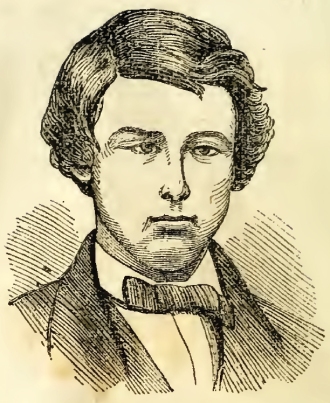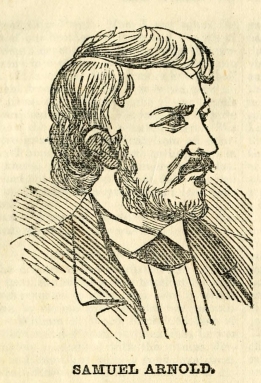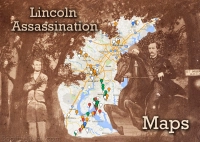There is a special connection between man and canine. As a species, dogs provide humans a degree of loyalty that is unmatched in the animal world. What’s even more interesting is how we, as people, develop the need to reciprocate that loyalty and devotion to our four legged friends. Just this month, New York enacted a new regulation allowing pet cemeteries to accept cremated human remains, so that humans could be buried for eternity with their beloved pets.
Dogs provide a comforting effect. Even in the most dire of circumstances they can provide an individual with a degree of ease and calm. Therefore, it seems fitting that, while imprisoned as accessories in the assassination of Abraham Lincoln, at least three of the conspirators’ thoughts were of their dogs.
David Herold met his end on the scaffold on July 7th, 1865. He demonstrated dog like devotion to John Wilkes Booth during his flight from justice. Despite many opportunities to leave the wounded assassin behind, Herold remained loyal to him and that loyalty eventually cost him his life. According to one newspaper account however, he was allowed the comfort of his own loyal friend before he died. In 1888, Captain Christian Rath gave an interview to the newspapers about his legacy of being the conspirators’ executioner. In part of the interview he stated, “I always regarded Harold as an unthinking boy – a spoiled child. He was a great sportsman, though, fond of shooting, and the owner of a splendid pointer dog. We kept the dog for him in the prison, and at his death he left it to Gen. Hartranft.” If Rath’s memory is correct and true, then it is likely that Herold spent his last few days on Earth uniting with the creature he so expertly replicated in life.
Edman Spangler survived the executions of July 7th. Instead he was sentenced to 6 years in prison, a relative slap on the wrist compared to the sentences of the other conspirators. Thomas Ewing, Jr., lawyer for Dr. Mudd, Samuel Arnold, and Spangler, wrote a letter to his father dated the day of the execution. In it, he described his continued efforts to gain the freedom of his clients through a writ of habeas corpus. He also wrote the following, “They say Spangler was delighted at escaping hanging. He sent a special request to Ford today to send him to prison his large testament, and his small dog!” Whether Spangler was successful in acquiring his dog remains uncertain as there is no mention of it, or David Herold’s dog, in General Frederick Hartranft’s letterbook about his supervision of the Old Arsenal Prison.
I find it ironically appropriate that Spangler owned a “small” dog. Years later, after his release from Fort Jefferson, Edman Spangler went to visit, and ultimately live with, his former cellmate, Dr. Mudd. As Nettie Mudd wrote later in her book about her father, “A short time after Spangler’s release, he came to our home early one morning, and his greeting to my mother, after father had introduced him, was: ‘Mrs. Mudd, I came down last night, and asked some one to tell me the way here. I followed the road, but when I arrived I was afraid of your dogs, and I roosted in a tree.'” Clearly Spangler preferred his small dog over big ones like Dr. Mudd’s.
Samuel Arnold was imprisoned with Dr. Mudd, Spangler and Michael O’Laughlen at Fort Jefferson. His later memoirs describe how painful and tortuous he found his imprisonment there. With only rats and crabs as his animal companions, Arnold’s thoughts turned to his dog. In a letter to his mother in 1867, Sam Arnold writes elegantly of his beloved pet:
“Keep my dog till he dies. For my sake let him be treated well, and when dead bury him. Erect a slab inscription, ‘A true friend,’ for he would never forsake me even should the whole world do so. He loved me, even the ground I walked upon, and I loved him. Poor Dash! We have forever parted. Thou without a soul, yet did you love me, and thou art not forgotten.”
The connection between man and dog transcends guilt or innocence. Whether its owner is a President or a criminal, a dog will stay by an owner who loves him. Even the worst criminals can demonstrate their humanity by the way they treat their dogs. In the midst of their confinement for the crime of the century, David Herold, Edman Spangler, and Samuel Arnold showed their humanity in this way.
References:
Mrs. Surratt’s Case, The Evening Repository, 2/16/1888
Thomas Ewing Family Papers, LOC
The Life of Dr. Samuel A. Mudd by Nettie Mudd
Memoirs of a Lincoln Conspirator by Michael Kauffman









Love this entry, Dave!
According to family, conspirator Lew Powell had a small motherless puppy which he had found. He nursed the pup around the clock, raised and carried around the little fellow with him until it was grown. Powell’s mother had made a “sugar tit” (a small cloth bag soaked in milk and sugar) with which to nurse the pup. Unfortunately, we don’t know the dog’s name. Powell had various pets as a boy, including puppies and kittens, a mule, guinea hens and a goat.
Thank you, Betty. I had a feeling that if there was a dog connection with Powell, you would know it. I believe that Booth had dogs as a child at Tudor Hall but I don’t have any specific story about Booth and a dog.
Wonderful post, Dave. Thank you. I like dogs, but I am a cat lover. Offhand, the only cat I can think of in the Lincoln assassination saga was Nora Fitzpatrick’s.
I can’t think of any cats in the assassination story either. I’m sure there were some felines around the Mudd farm though to catch rats.
I’m sure it isn’t so, but I wonder, anyway, if a grave marker — made as Sam Arnold instructed –exists for his dog, or for any of his dogs near the still-standing house you visited a few mos. ago.
Well Sam did not spend as long in prison as he thought he was going to, Richard. So I’d like to think that when he got home two years later, Dash was still alive and greeted his master with an affectionate bark and lick.
Poor Dash !
I don’t know if Arnold meant to reference Shakespeare, but that line always reminds me of Hamlet: “Alas, poor Yorick! I knew him”
This may break the spell. According to Thomas Harbin, late in January 1864 Booth and Herold rode to Port Tobacco and, together with Atzerodt inspected the boat Surratt had purchased. Booth shot a vicious dog which barked and nipped at his heels. See Townsend, Katy of Catoctin, 473.
Thanks, Art. With Booth’s final writing about being “hunted like a dog” and his note to Dr. Stuart regarding how he “wouldn’t have turned a dog away” in his condition, I had expected him to have had a better attitude towards dogs.
Dave — I don’t know if it is relevant because the “pet” is not identified (and I have not tried to trace the source), but there is a line in Nora Titone’s book: “When a much-loved family pet bit John unexpectedly, he was inconsolable, taking the incident personally, saying he felt betrayed by the creature.” (p. 133) Without trying to read too much into that, it may suggest that JWB may not have been fond of dogs after being bit. Just a thought….
Great post, Fido liked it too.
I think I remember reading somewhere that Booth shot both a neighbor’s dog and another neighbor’s hog during his youth. My father always said not to trust a person who didn’t like animals.
I think that the animal which bit Wilkes as a youth was his colt, Cola. He supposedly mourned to sister, Asia, “I love the animal so! A playful nip is one thing but to turn and just bite is plain vicious!” (I may have the wording wrong, but this is the grist of it. Another source also stated that Wilkes killed all the cats around the farm…..don’t know the validity of this or not.
Hi Betty. I do not know his source, but GATH wrote this in “The Life, Crime and Capture of John Wilkes Booth:”
“I have heard it said as the only evidence of Booth’s ferocity in those early times that he was always shooting cats, and killed off almost the entire breed in his neighbourhood.”
Sounds like “Kitty Kitty Bang Bang.”